
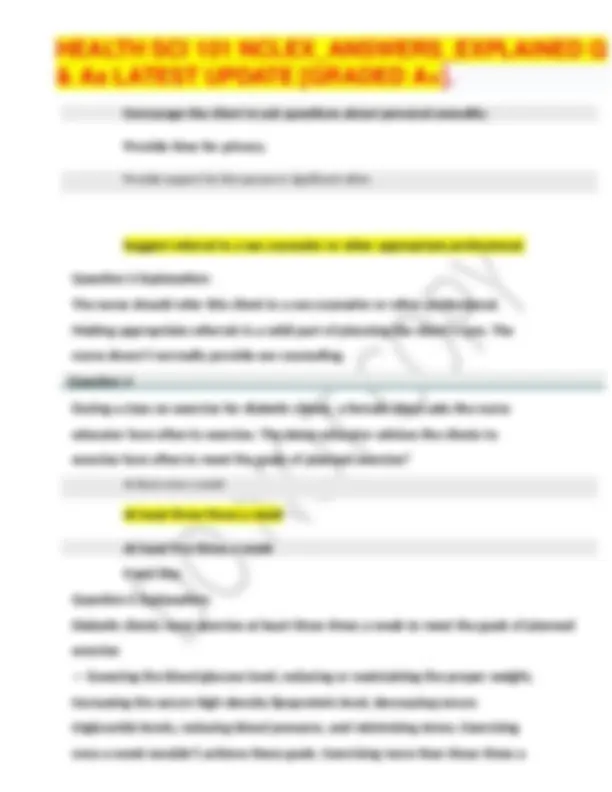
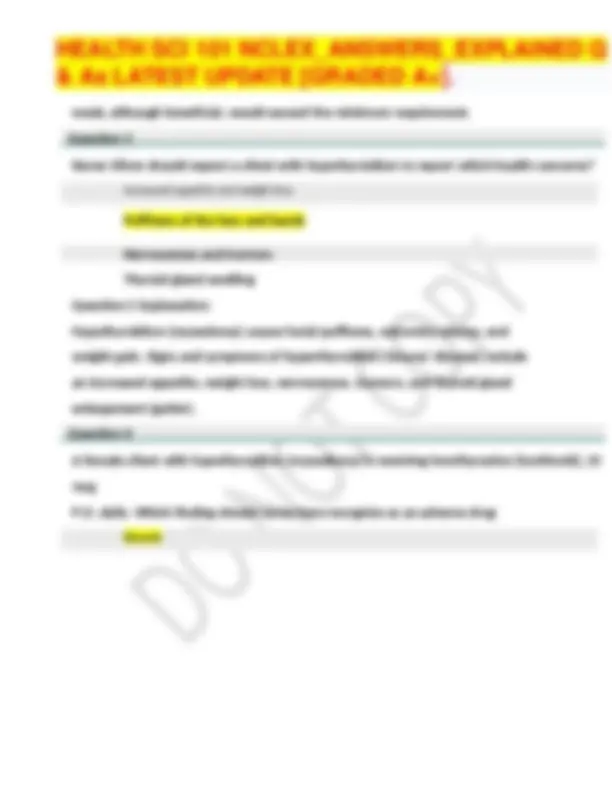
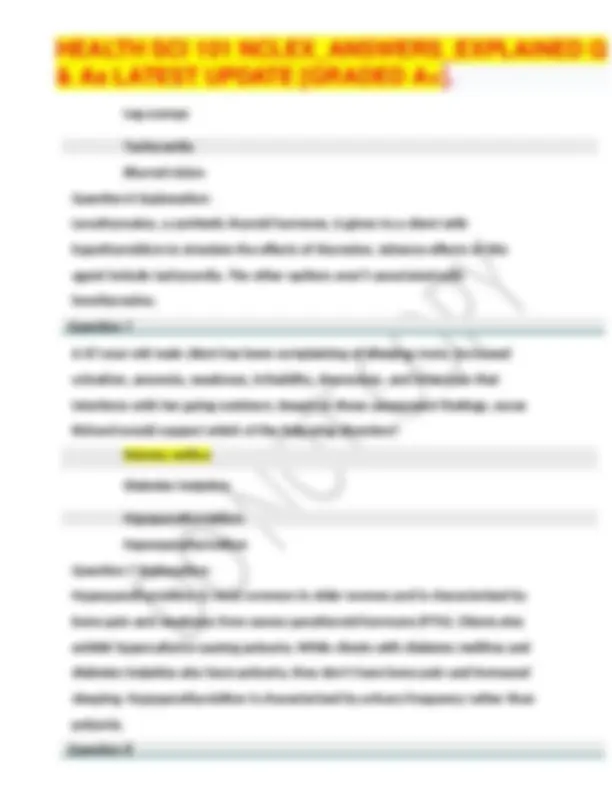
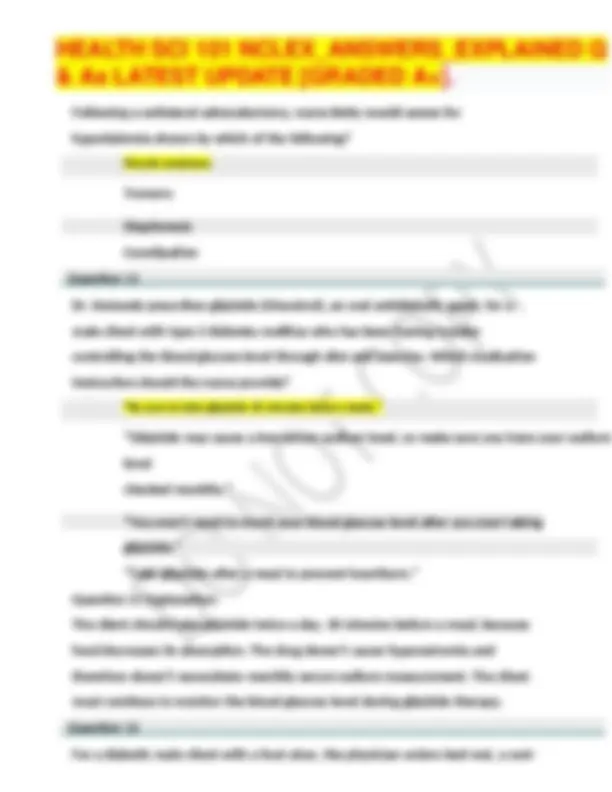
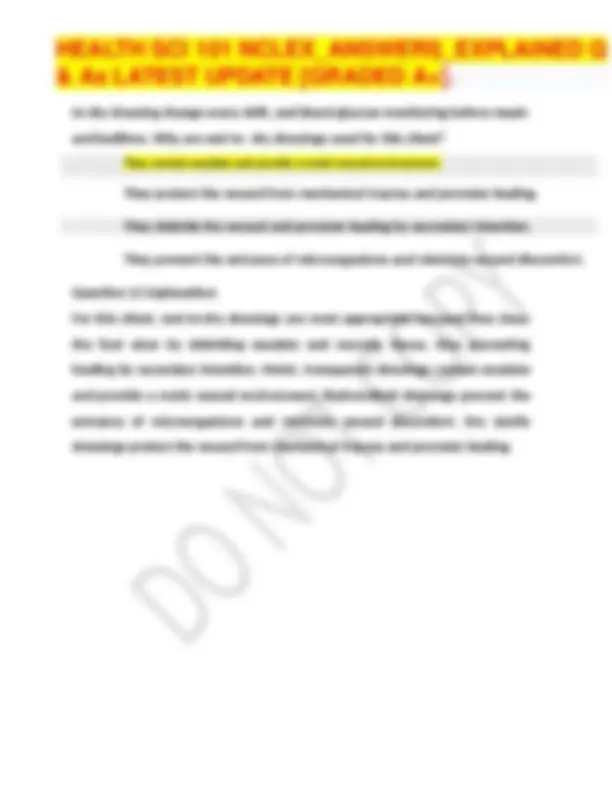
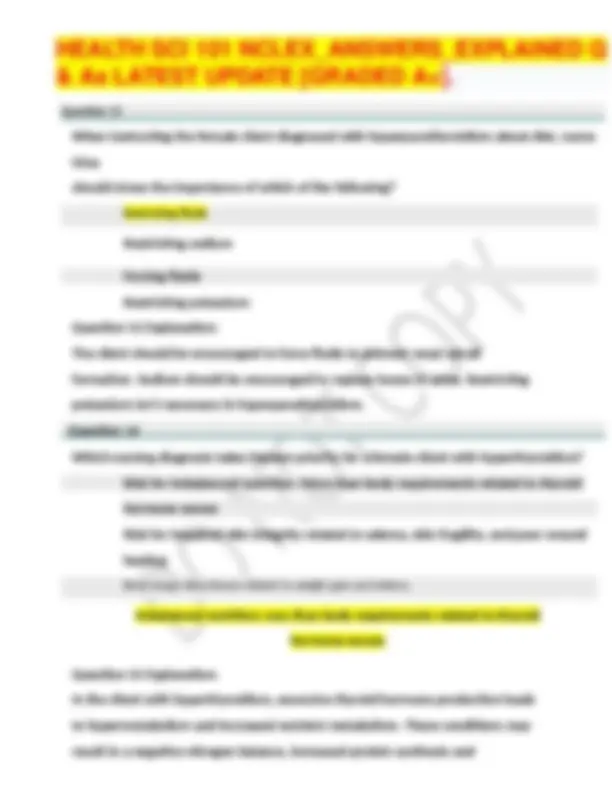
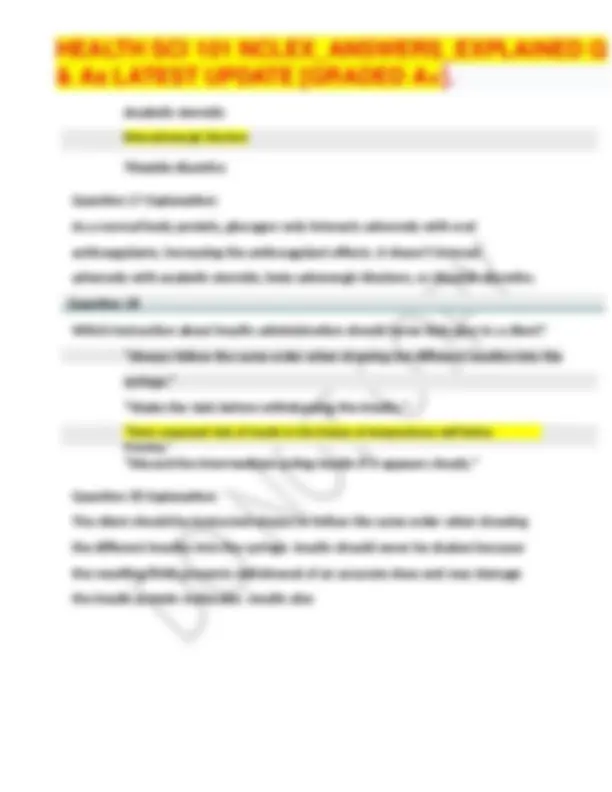
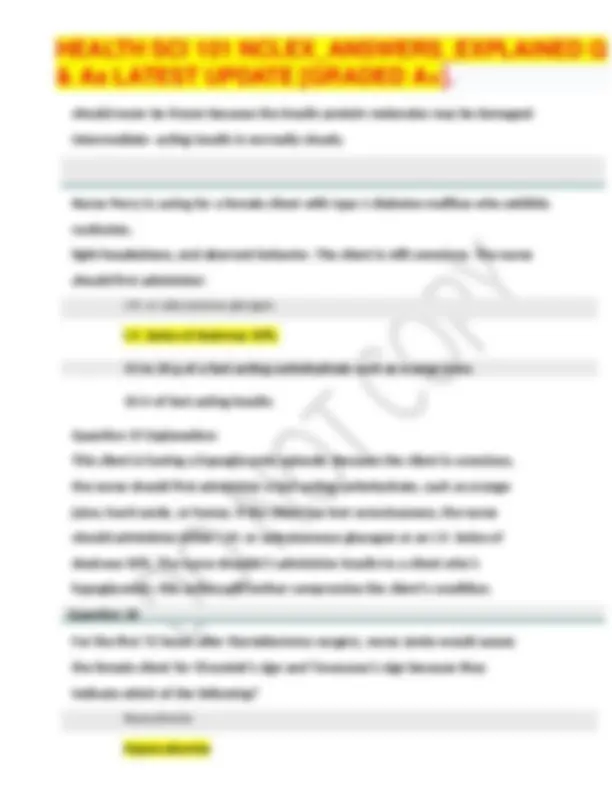
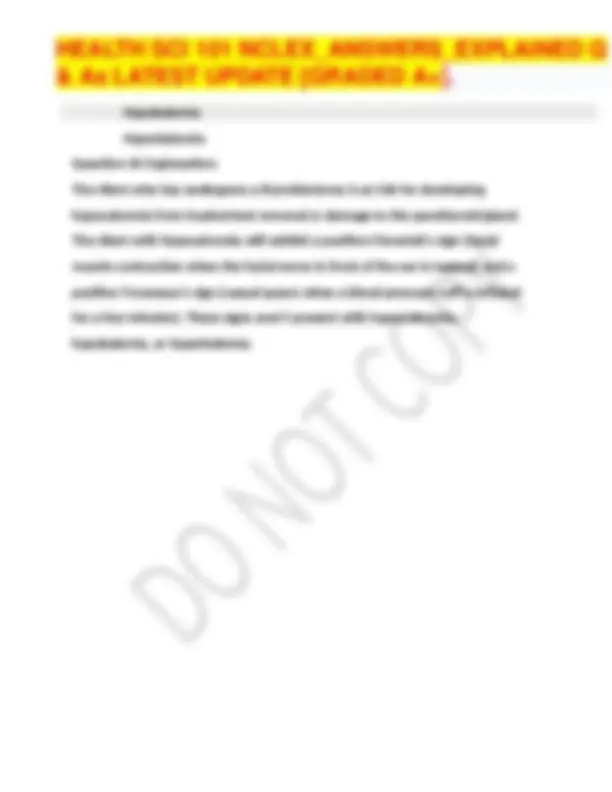
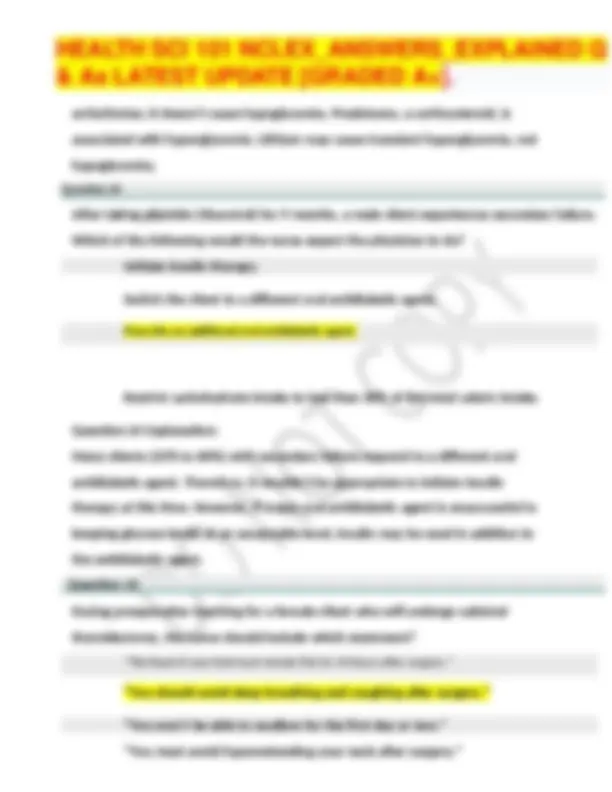
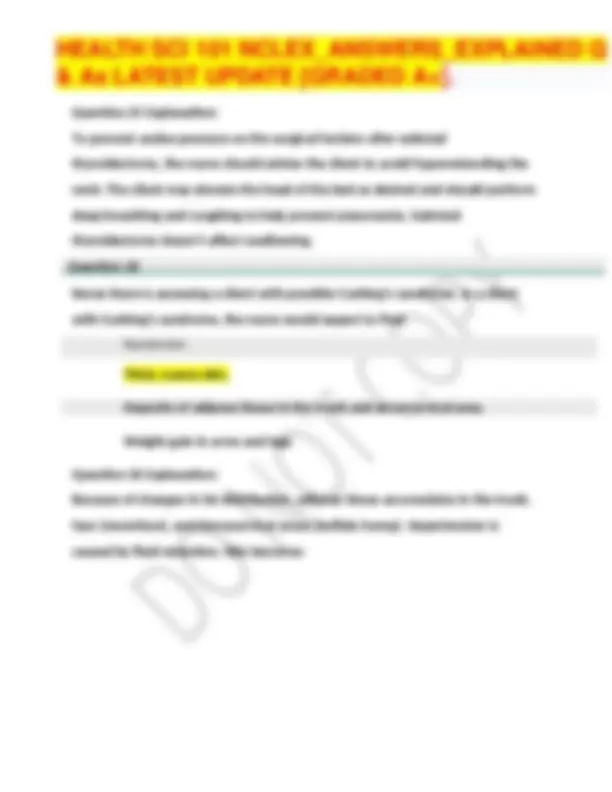
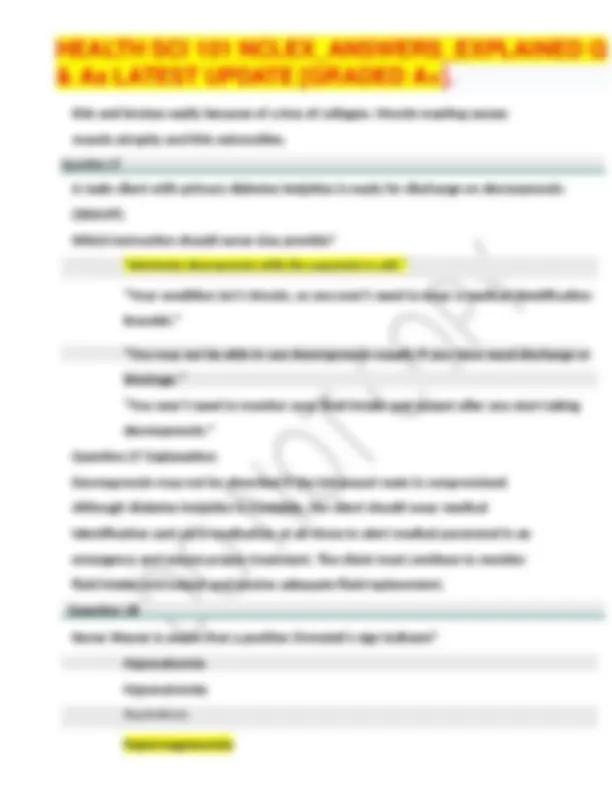
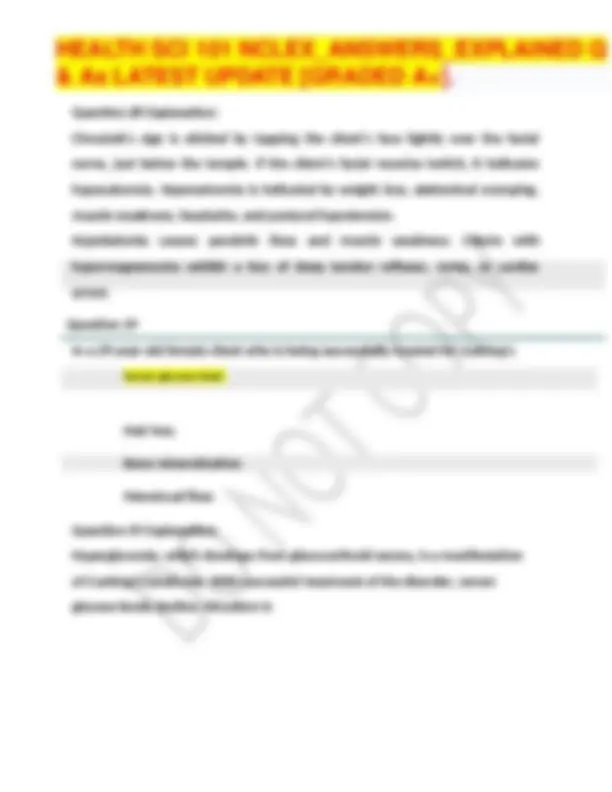
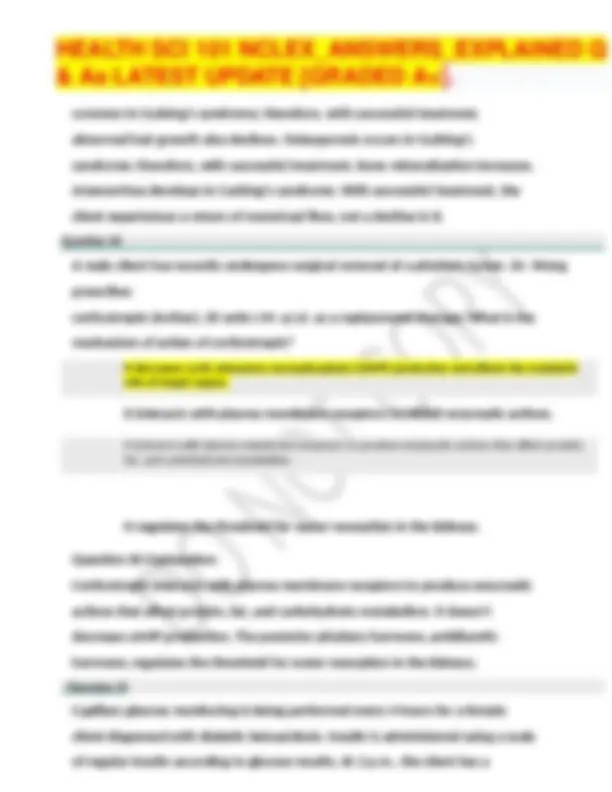
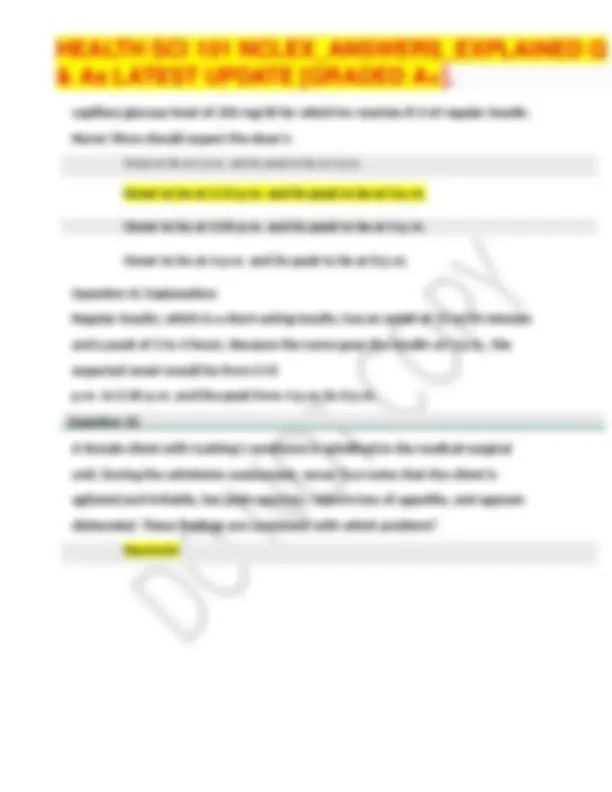
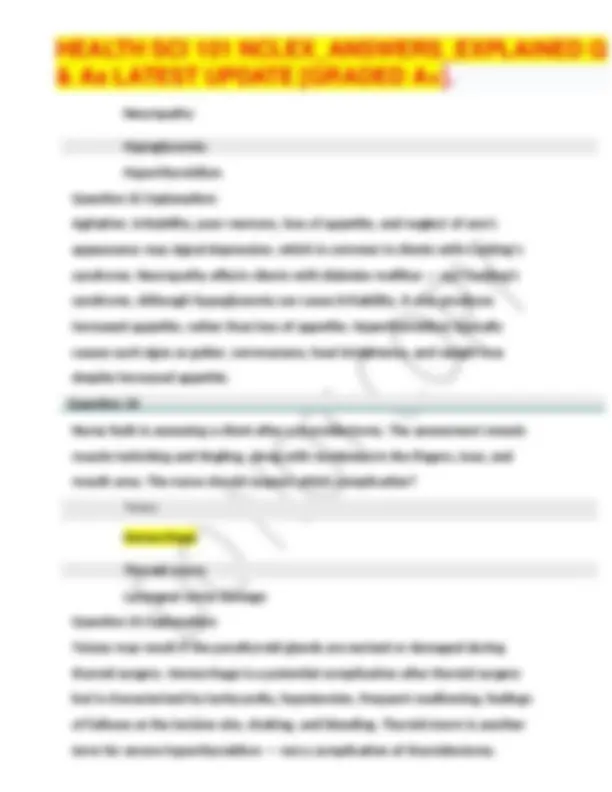
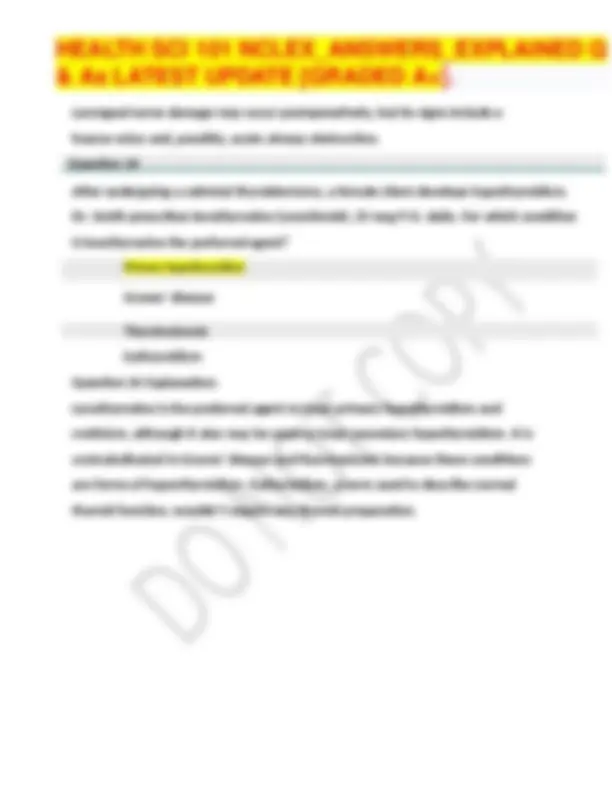
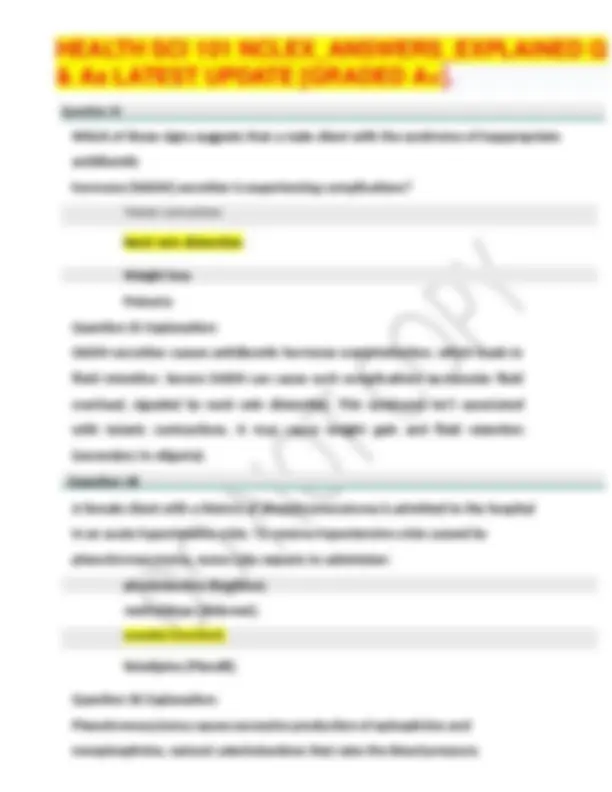
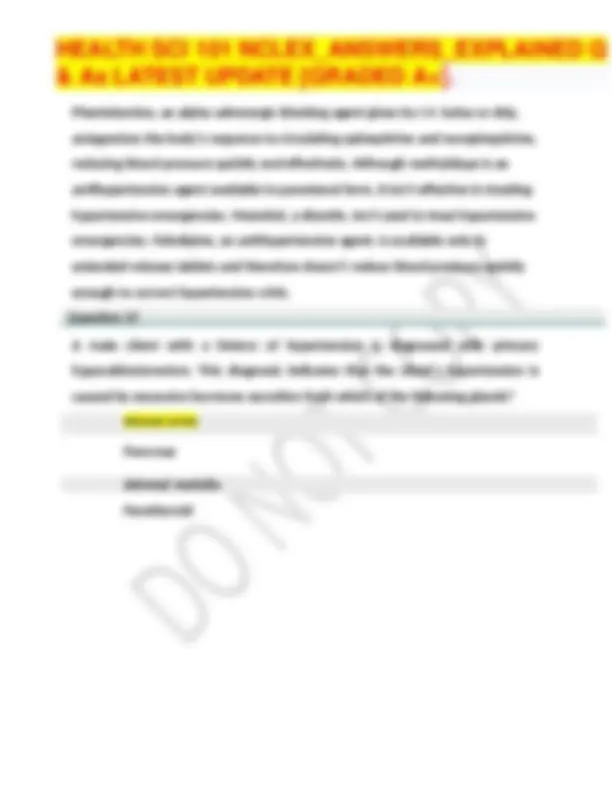
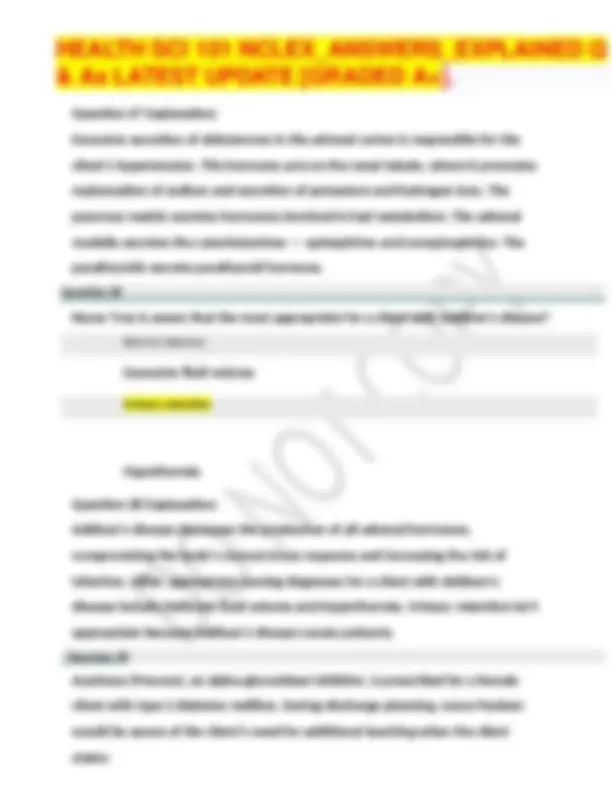
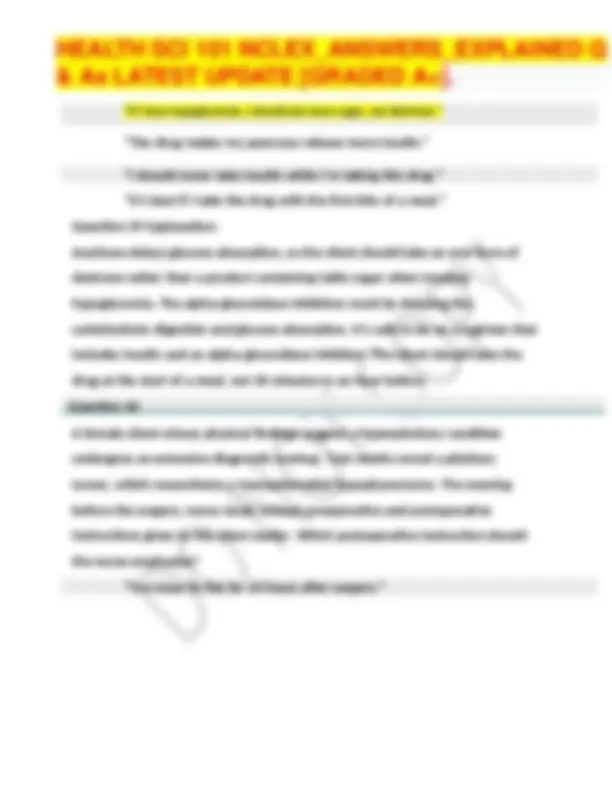
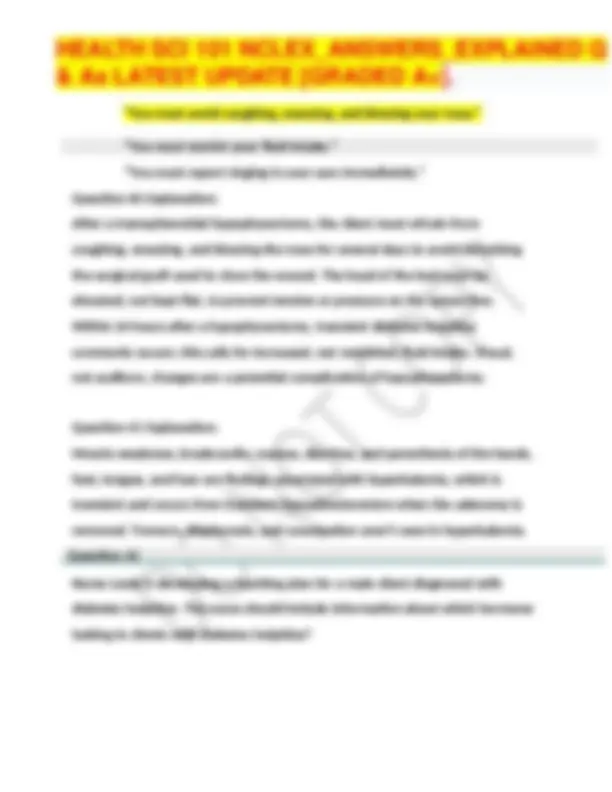
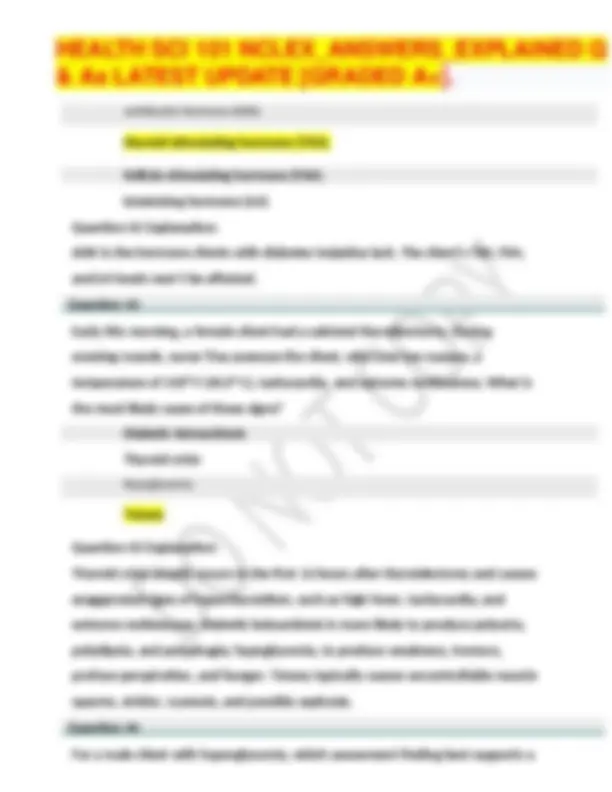
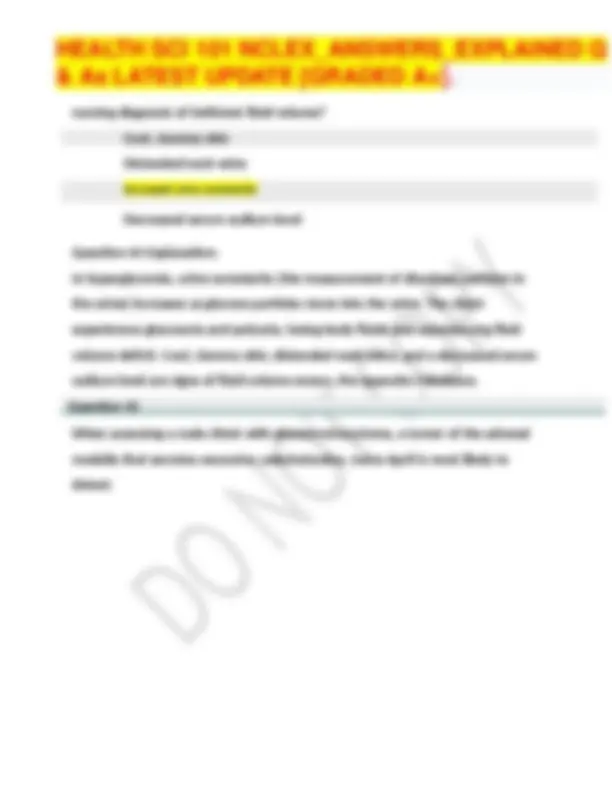
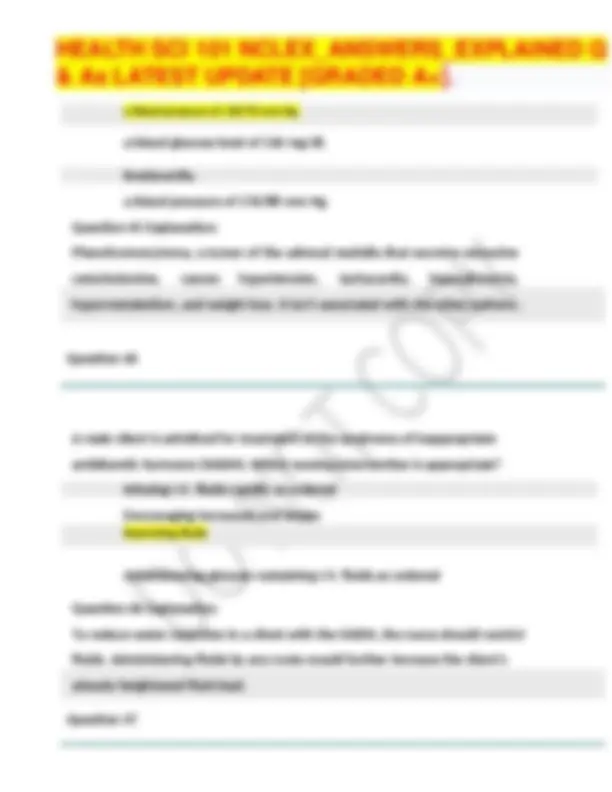
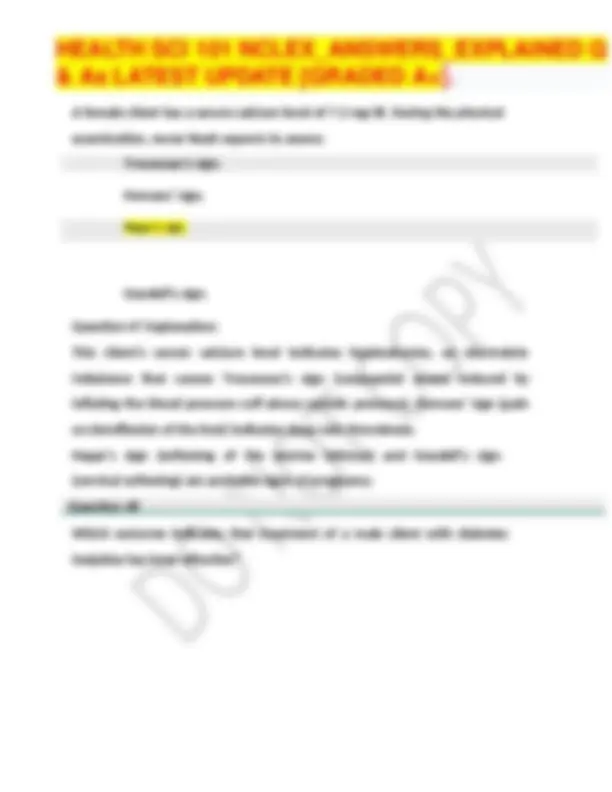
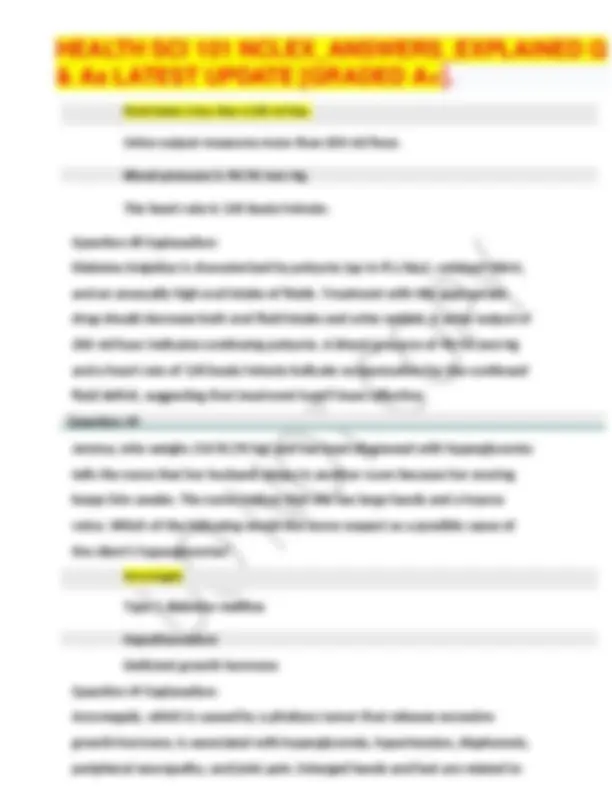
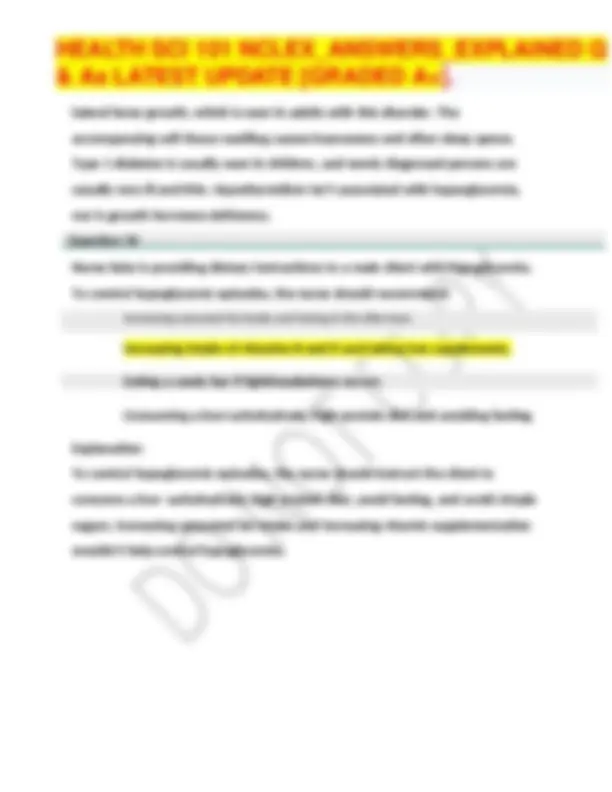


Study with the several resources on Docsity

Earn points by helping other students or get them with a premium plan


Prepare for your exams
Study with the several resources on Docsity

Earn points to download
Earn points by helping other students or get them with a premium plan
Community
Ask the community for help and clear up your study doubts
Discover the best universities in your country according to Docsity users
Free resources
Download our free guides on studying techniques, anxiety management strategies, and thesis advice from Docsity tutors
A series of nursing questions and answers related to the care of clients with diabetes mellitus, diabetes insipidus, and thyroid disorders. Topics include signs and symptoms, medications, and nursing diagnoses. Students can use this document as study notes, summaries, or cheat sheets to prepare for exams.
Typology: Exams
1 / 36

This page cannot be seen from the preview
Don't miss anything!





























An agitated, confused female client arrives in the emergency department. Her history includes type 1 diabetes mellitus, hypertension, and angina pectoris. Assessment reveals pallor, diaphoresis, headache, and intense hunger. A stat blood glucose sample measures 42 mg/dl, and the client is treated for an acute hypoglycemic reaction. After recovery, the nurse teaches the client to treat hypoglycemia by ingesting: 10 to 15 g of a simple carbohydrate. 18 to 20 g of a simple carbohydrate. 25 to 30 g of a simple carbohydrate. Question 1 Explanation: To reverse hypoglycemia, the American Diabetes Association recommends ingesting 10 to 15 g of a simple carbohydrate, such as three to five pieces of hard candy, two to three packets of sugar (4 to 6 tsp), or 4 oz of fruit juice. If necessary, this treatment can be repeated in 15 minutes. Ingesting only 2 to 5 g of a simple carbohydrate may not raise the blood glucose level sufficiently. Ingesting more than 15 g may raise it above normal, causing hyperglycemia. Question 2 A female adult client with a history of chronic hyperparathyroidism admits to being noncompliant. Based on initial assessment findings, the nurse formulates the nursing diagnosis of Risk for injury. To complete the nursing diagnosis statement for this client, which “related-to” phrase should the nurse add? Related to bone demineralization resulting in pathologic fractures Question 1 2 to 5 g of a simple carbohydrate.
Related to exhaustion secondary to an accelerated metabolic rate Related to tetany secondary to a decreased serum calcium level Question 2 Explanation: Poorly controlled hyperparathyroidism may cause an elevated serum calcium level. This, in turn, may diminish calcium stores in the bone, causing bone demineralization and setting the stage for pathologic fractures and a risk for injury. Hyperparathyroidism doesn’t accelerate the metabolic rate. A decreased thyroid hormone level, not an increased parathyroid hormone level, may cause edema and dry skin secondary to fluid infiltration into the interstitial spaces. Hyperparathyroidism causes hypercalcemia, not hypocalcemia; therefore, it isn’t associated with tetany. Question 3 Nurse Joey is assigned to care for a postoperative male client who has diabetes mellitus. During the assessment interview, the client reports that he’s impotent and says he’s concerned about its effect on his marriage. In planning this client’s care, the most appropriate intervention would be to:
week, although beneficial, would exceed the minimum requirement. Question 5 Nurse Oliver should expect a client with hypothyroidism to report which health concerns? Puffiness of the face and hands Nervousness and tremors Thyroid gland swelling Question 5 Explanation: Hypothyroidism (myxedema) causes facial puffiness, extremity edema, and weight gain. Signs and symptoms of hyperthyroidism (Graves’ disease) include an increased appetite, weight loss, nervousness, tremors, and thyroid gland enlargement (goiter). Question 6 A female client with hypothyroidism (myxedema) is receiving levothyroxine (Synthroid), 25 mcg P.O. daily. Which finding should nurse Hans recognize as an adverse drug Increased appetite and weight loss Dysuria
Leg cramps Tachycardia Blurred vision Question 6 Explanation: Levothyroxine, a synthetic thyroid hormone, is given to a client with hypothyroidism to simulate the effects of thyroxine. Adverse effects of this agent include tachycardia. The other options aren’t associated with levothyroxine. Question 7 A 67-year-old male client has been complaining of sleeping more, increased urination, anorexia, weakness, irritability, depression, and bone pain that interferes with her going outdoors. Based on these assessment findings, nurse Richard would suspect which of the following disorders? Diabetes insipidus Hypoparathyroidism Hyperparathyroidism Question 7 Explanation: Hyperparathyroidism is most common in older women and is characterized by bone pain and weakness from excess parathyroid hormone (PTH). Clients also exhibit hypercaliuria-causing polyuria. While clients with diabetes mellitus and diabetes insipidus also have polyuria, they don’t have bone pain and increased sleeping. Hypoparathyroidism is characterized by urinary frequency rather than polyuria. Question 8 Diabetes mellitus
A pituitary adenoma An adrenal adenoma Question 9 Explanation: An autonomous aldosterone-producing adenoma is the most common cause of hyperaldosteronism. Hyperplasia is the second most frequent cause. Aldosterone secretion is independent of sodium and potassium intake as well as of pituitary stimulation. A male client with type 1 diabetes mellitus has a highly elevated glycosylated hemoglobin (Hb) test result. In discussing the result with the client, nurse Sharmaine would be most accurate in stating: “The test needs to be repeated following a 12-hour fast.” “It looks like you aren’t following the prescribed diabetic diet.” “It tells us about your sugar control for the last 3 months.” “Your insulin regimen needs to be altered significantly.” Question 10 Explanation: The glycosylated Hb test provides an objective measure of glycemic control over a 3-month period. The test helps identify trends or practices that impair glycemic control, and it doesn’t require a fasting period before blood is drawn. The nurse can’t conclude that the result occurs from poor dietary management or inadequate insulin coverage. Question 11 Question 10 WRONG Deficient potassium intake
Following a unilateral adrenalectomy, nurse Betty would assess for hyperkalemia shown by which of the following? Tremors Diaphoresis Constipation Question 11 Dr. Kennedy prescribes glipizide (Glucotrol), an oral antidiabetic agent, for a male client with type 2 diabetes mellitus who has been having trouble controlling the blood glucose level through diet and exercise. Which medication instruction should the nurse provide? “Glipizide may cause a low serum sodium level, so make sure you have your sodium level checked monthly.” “You won’t need to check your blood glucose level after you start taking glipizide.” “Take glipizide after a meal to prevent heartburn.” Question 11 Explanation: The client should take glipizide twice a day, 30 minutes before a meal, because food decreases its absorption. The drug doesn’t cause hyponatremia and therefore doesn’t necessitate monthly serum sodium measurement. The client must continue to monitor the blood glucose level during glipizide therapy. Question 12 For a diabetic male client with a foot ulcer, the physician orders bed rest, a wet- Muscle weakness “Be sure to take glipizide 30 minutes before meals.”
When instructing the female client diagnosed with hyperparathyroidism about diet, nurse Gina should stress the importance of which of the following? Restricting sodium Forcing fluids Restricting potassium Question 13 Explanation: The client should be encouraged to force fluids to prevent renal calculi formation. Sodium should be encouraged to replace losses in urine. Restricting potassium isn’t necessary in hyperparathyroidism. Question 14 Which nursing diagnosis takes highest priority for a female client with hyperthyroidism? Risk for imbalanced nutrition: More than body requirements related to thyroid hormone excess Risk for impaired skin integrity related to edema, skin fragility, and poor wound healing Imbalanced nutrition: Less than body requirements related to thyroid hormone excess Question 14 Explanation: In the client with hyperthyroidism, excessive thyroid hormone production leads to hypermetabolism and increased nutrient metabolism. These conditions may result in a negative nitrogen balance, increased protein synthesis and Question 13 Restricting fluids Body image disturbance related to weight gain and edema
breakdown, decreased glucose tolerance, and fat mobilization and depletion. This puts the client at risk for marked nutrient and calorie deficiency, making Imbalanced nutrition: Less than body requirements the most important nursing diagnosis. Options B and C may be appropriate for a client with hypothyroidism, which slows the metabolic rate. Question 15 A male client with a tentative diagnosis of hyperosmolar hyperglycemic nonketotic syndrome (HHNS) has a history of type 2 diabetes that is being controlled with an oral diabetic agent, tolazamide (Tolinase). Which of the following is the most important laboratory test for confirming this disorder? Serum potassium level Serum sodium level Serum osmolarity Question 15 Explanation: Serum osmolarity is the most important test for confirming HHNS; it’s also used to guide treatment strategies and determine evaluation criteria. A client with HHNS typically has a serum Arterial blood gas (ABG) values
Anabolic steroids Thiazide diuretics Question 17 Explanation: As a normal body protein, glucagon only interacts adversely with oral anticoagulants, increasing the anticoagulant effects. It doesn’t interact adversely with anabolic steroids, beta-adrenergic blockers, or thiazide diuretics. Question 18 Which instruction about insulin administration should nurse Kate give to a client? “Always follow the same order when drawing the different insulins into the syringe.” “Shake the vials before withdrawing the insulin.” “Discard the intermediate-acting insulin if it appears cloudy.” Question 18 Explanation: The client should be instructed always to follow the same order when drawing the different insulins into the syringe. Insulin should never be shaken because the resulting froth prevents withdrawal of an accurate dose and may damage the insulin protein molecules. Insulin also “Store unopened vials of insulin in the freezer at temperatures well below freezing.” Beta-adrenergic blockers
should never be frozen because the insulin protein molecules may be damaged. Intermediate- acting insulin is normally cloudy. Nurse Perry is caring for a female client with type 1 diabetes mellitus who exhibits confusion, light-headedness, and aberrant behavior. The client is still conscious. The nurse should first administer: I.V. bolus of dextrose 50%. 15 to 20 g of a fast-acting carbohydrate such as orange juice. 10 U of fast-acting insulin. Question 19 Explanation: This client is having a hypoglycemic episode. Because the client is conscious, the nurse should first administer a fast-acting carbohydrate, such as orange juice, hard candy, or honey. If the client has lost consciousness, the nurse should administer either I.M. or subcutaneous glucagon or an I.V. bolus of dextrose 50%. The nurse shouldn’t administer insulin to a client who’s hypoglycemic; this action will further compromise the client’s condition. Question 20 For the first 72 hours after thyroidectomy surgery, nurse Jamie would assess the female client for Chvostek’s sign and Trousseau’s sign because they indicate which of the following? Hypercalcemia I.M. or subcutaneous glucagon. Hypocalcemia
An incoherent female client with a history of hypothyroidism is brought to the emergency department by the rescue squad. Physical and laboratory findings reveal hypothermia, hypoventilation, respiratory acidosis, bradycardia, hypotension, and nonpitting edema of the face and pretibial area. Knowing that these findings suggest severe hypothyroidism, nurse Libby prepares to take emergency action to prevent the potential complication of: Cretinism. Hashimoto’s thyroiditis. Question 21 Explanation: Severe hypothyroidism may result in myxedema coma, in which a drastic drop in the metabolic rate causes decreased vital signs, hypoventilation (possibly leading to respiratory acidosis), and nonpitting edema. Thyroid storm is an acute complication of hyperthyroidism. Cretinism is a form of hypothyroidism that occurs in infants. Hashimoto’s thyroiditis is a common chronic inflammatory disease of the thyroid gland in which autoimmune factors play a prominent role. A male client with type 1 diabetes mellitus asks the nurse about taking an oral antidiabetic agent. Nurse Jack explains that these medications are only effective if the client: Question 21 Question 22 Myxedema coma. Thyroid storm. prefers to take insulin orally.
has type 2 diabetes. has type 1 diabetes. is pregnant and has type 2 diabetes. Question 22 Explanation: Oral antidiabetic agents are only effective in adult clients with type 2 diabetes. Oral antidiabetic agents aren’t effective in type 1 diabetes. Pregnant and lactating women aren’t prescribed oral antidiabetic agents because the effect on the fetus is uncertain. Question 23 When caring for a female client with a history of hypoglycemia, nurse Ruby should avoid administering a drug that may potentiate hypoglycemia. Which drug fits this description? mexiletine (Mexitil) prednisone (Orasone) lithium carbonate (Lithobid) Question 23 Explanation: Sulfisoxazole and other sulfonamides are chemically related to oral antidiabetic agents and may precipitate hypoglycemia. Mexiletine, an antiarrhythmic, is used to treat refractory ventricular sulfisoxazole (Gantrisin)
Question 25 Explanation: To prevent undue pressure on the surgical incision after subtotal thyroidectomy, the nurse should advise the client to avoid hyperextending the neck. The client may elevate the head of the bed as desired and should perform deep breathing and coughing to help prevent pneumonia. Subtotal thyroidectomy doesn’t affect swallowing. Question 26 Nurse Ronn is assessing a client with possible Cushing’s syndrome. In a client with Cushing’s syndrome, the nurse would expect to find: Thick, coarse skin. Deposits of adipose tissue in the trunk and dorsocervical area. Weight gain in arms and legs. Question 26 Explanation: Because of changes in fat distribution, adipose tissue accumulates in the trunk, face (moonface), and dorsocervical areas (buffalo hump). Hypertension is caused by fluid retention. Skin becomes Hypotension.
thin and bruises easily because of a loss of collagen. Muscle wasting causes muscle atrophy and thin extremities. A male client with primary diabetes insipidus is ready for discharge on desmopressin (DDAVP). Which instruction should nurse Lina provide? “Your condition isn’t chronic, so you won’t need to wear a medical identification bracelet.” “You may not be able to use desmopressin nasally if you have nasal discharge or blockage.” “You won’t need to monitor your fluid intake and output after you start taking desmopressin.” Question 27 Explanation: Desmopressin may not be absorbed if the intranasal route is compromised. Although diabetes insipidus is treatable, the client should wear medical identification and carry medication at all times to alert medical personnel in an emergency and ensure proper treatment. The client must continue to monitor fluid intake and output and receive adequate fluid replacement. Question 28 Nurse Wayne is aware that a positive Chvostek’s sign indicate? Hypocalcemia Hyponatremia Hypermagnesemia Question 27 “Administer desmopressin while the suspension is cold.” Hypokalemia